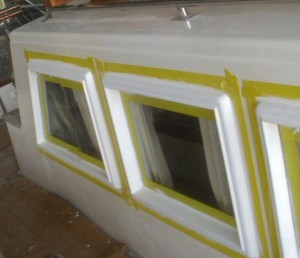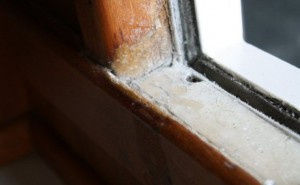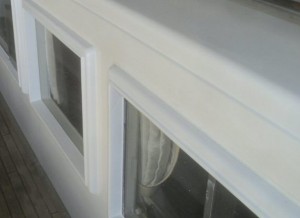I was just going to post “I got nuthin” but that would be a cop out (I guess) since I had “nuthin” yesterday either and I was not here on Tuesday – not really a fun day, a family matter arose. I understand I may be off tomorrow — we’ll see. But on to something at least a bit concrete.
I had a call yesterday from a nice fellow with a Grand Banks 32 (actually a writer for noted marine publications but I don’t drop names here) who asked about his sliding window problem. He obviously has not read our service log. There is gold in them there hills — so I offer another reprint.
October 1st, 2012
 So you need a window job?
So you need a window job?
If you own a Grand Banks you will need a window job at some point. We consider window painting routine maintenance but when the tracks finally go south they will need to be replaced. This is no small job since the frames need to be removed to replace the track. The most important thing is to maintain those windows.
I want to outline the two jobs separately so doing track replacement will require it’s own posting. For the routine maintenance you also need to add keeping the window tracks maintained — which will delay the track replacement considerably. Let’s start there.
The track relies on “fuzzy felt” to maintain it’s ability to keep the window tight and watertight. This will start to harden as it fills with dirt and debris which inhibits it’s ability to do the job intended. The movement of the window against the material will start compressing the dirt which by it’s basic nature will attract more dirt which in turn compacts onto the mass which is forming. Your best friend here is an ordinary household toothbrush. It should fit down into the track nicely and will help get the dirt out. If you do it often use a dry brush — medium bristle. If you have waited you may need to introduce a little soap. Once again, some household variety dish detergent should do the trick, just grab some from beneath your sink and you’re set. Don’t go overboard with the soap, you will need to get it out so it doesn’t cause more problems as the moisture evaporates. Just mix a bit in some water and give the track a good scrubbing. Then wash out your brush and clean with some clean water and repeat (and repeat again.)
 Left : Window drain with surrounding damage
Left : Window drain with surrounding damage
This is a good time to check the drain holes for proper drainage. If the water doesn’t drain out it will go around the glass and end up inside the boat. When this happens you have even more problems as it will cause discoloration, paint peeling, wood rot and veneer delamination around the windows — you don’t want that, do you?
With the inside maintenance complete you can move to painting the windows. A maintenance coat is a piece of cake, just a bit of taping, some sanding and put on a bit of paint but the real challenge is when the windows have been let go way past the mere maintenance stage. This will require real work. You could just scape the bad spots but rarely will you make them disappear if you have a lot of scraping to do. If you have a lot of patches you are better off just stripping the windows and starting with a good sound base. You don’t really want to use a heat gun to do this — it’s too close to the glass and not that good for bedding either. Judicious use of strippers and good sanding is the best way. Get it clean, get it smooth and you’ll be pleased with the result, if you grow weary of sanding, you won’t.
Primer — the best primer to use for the windows to give the job a long life is a penetrating epoxy (CPES). This will seal and limit wood movement. If you are just doing a few repairs stick to a good marine topcoat primer or epoxy primer. Interlux makes a good epoxy primer which would work good for this —
Interlux Epoxy Primekote. We use it for lots of other stuff around the yard.
Top Coat — for longevity you should consider one of the catalyzed two-part paints such as Awlgrip. These will outlast a marine enamel by many years but require much more work to apply. To start with you will need to use the penetrating epoxy to seal the frames. This is important because these paints are very hard and will not move with the wood so you need to limit the expanding and contracting of the wood. You will also need the recommended primer on top of the epoxy. If you try to skip this step thinking you have primed with the epoxy then you will be disappointed when the paint falls off. If you already have enamel on the window, but all means use that for subsequent coats. We generally use Interux Britesides but Pettit Easypoxy is also a good product for this.
 Color
Color — we often get asked what color to paint the frames. We have seen almost every shade of white used on the frames and have often just used a white we had in stock. Here’s the rule of thumb though, if you have done an immaculate job on the windows and want to showcase them, use a brighter white but you will find that painting them the same color as the surrounding gelcoat makes them virtually disappear. Awlgrip comes in Grand Banks White (the standard gelcoat color) but it is a special order color however.
Now that you have your windows in good shape a regular inspection of the paint will allow you to do touch ups as needed to protect the job. At the first sign of cracked paint or peeling, seal it up with some fresh paint immediately to keep water from penetrating and ruining your job.
 So you need a window job?
If you own a Grand Banks you will need a window job at some point. We consider window painting routine maintenance but when the tracks finally go south they will need to be replaced. This is no small job since the frames need to be removed to replace the track. The most important thing is to maintain those windows.
I want to outline the two jobs separately so doing track replacement will require it’s own posting. For the routine maintenance you also need to add keeping the window tracks maintained — which will delay the track replacement considerably. Let’s start there.
The track relies on “fuzzy felt” to maintain it’s ability to keep the window tight and watertight. This will start to harden as it fills with dirt and debris which inhibits it’s ability to do the job intended. The movement of the window against the material will start compressing the dirt which by it’s basic nature will attract more dirt which in turn compacts onto the mass which is forming. Your best friend here is an ordinary household toothbrush. It should fit down into the track nicely and will help get the dirt out. If you do it often use a dry brush — medium bristle. If you have waited you may need to introduce a little soap. Once again, some household variety dish detergent should do the trick, just grab some from beneath your sink and you’re set. Don’t go overboard with the soap, you will need to get it out so it doesn’t cause more problems as the moisture evaporates. Just mix a bit in some water and give the track a good scrubbing. Then wash out your brush and clean with some clean water and repeat (and repeat again.)
So you need a window job?
If you own a Grand Banks you will need a window job at some point. We consider window painting routine maintenance but when the tracks finally go south they will need to be replaced. This is no small job since the frames need to be removed to replace the track. The most important thing is to maintain those windows.
I want to outline the two jobs separately so doing track replacement will require it’s own posting. For the routine maintenance you also need to add keeping the window tracks maintained — which will delay the track replacement considerably. Let’s start there.
The track relies on “fuzzy felt” to maintain it’s ability to keep the window tight and watertight. This will start to harden as it fills with dirt and debris which inhibits it’s ability to do the job intended. The movement of the window against the material will start compressing the dirt which by it’s basic nature will attract more dirt which in turn compacts onto the mass which is forming. Your best friend here is an ordinary household toothbrush. It should fit down into the track nicely and will help get the dirt out. If you do it often use a dry brush — medium bristle. If you have waited you may need to introduce a little soap. Once again, some household variety dish detergent should do the trick, just grab some from beneath your sink and you’re set. Don’t go overboard with the soap, you will need to get it out so it doesn’t cause more problems as the moisture evaporates. Just mix a bit in some water and give the track a good scrubbing. Then wash out your brush and clean with some clean water and repeat (and repeat again.)
 Left : Window drain with surrounding damage
This is a good time to check the drain holes for proper drainage. If the water doesn’t drain out it will go around the glass and end up inside the boat. When this happens you have even more problems as it will cause discoloration, paint peeling, wood rot and veneer delamination around the windows — you don’t want that, do you?
With the inside maintenance complete you can move to painting the windows. A maintenance coat is a piece of cake, just a bit of taping, some sanding and put on a bit of paint but the real challenge is when the windows have been let go way past the mere maintenance stage. This will require real work. You could just scape the bad spots but rarely will you make them disappear if you have a lot of scraping to do. If you have a lot of patches you are better off just stripping the windows and starting with a good sound base. You don’t really want to use a heat gun to do this — it’s too close to the glass and not that good for bedding either. Judicious use of strippers and good sanding is the best way. Get it clean, get it smooth and you’ll be pleased with the result, if you grow weary of sanding, you won’t.
Primer — the best primer to use for the windows to give the job a long life is a penetrating epoxy (CPES). This will seal and limit wood movement. If you are just doing a few repairs stick to a good marine topcoat primer or epoxy primer. Interlux makes a good epoxy primer which would work good for this — Interlux Epoxy Primekote. We use it for lots of other stuff around the yard.
Top Coat — for longevity you should consider one of the catalyzed two-part paints such as Awlgrip. These will outlast a marine enamel by many years but require much more work to apply. To start with you will need to use the penetrating epoxy to seal the frames. This is important because these paints are very hard and will not move with the wood so you need to limit the expanding and contracting of the wood. You will also need the recommended primer on top of the epoxy. If you try to skip this step thinking you have primed with the epoxy then you will be disappointed when the paint falls off. If you already have enamel on the window, but all means use that for subsequent coats. We generally use Interux Britesides but Pettit Easypoxy is also a good product for this.
Left : Window drain with surrounding damage
This is a good time to check the drain holes for proper drainage. If the water doesn’t drain out it will go around the glass and end up inside the boat. When this happens you have even more problems as it will cause discoloration, paint peeling, wood rot and veneer delamination around the windows — you don’t want that, do you?
With the inside maintenance complete you can move to painting the windows. A maintenance coat is a piece of cake, just a bit of taping, some sanding and put on a bit of paint but the real challenge is when the windows have been let go way past the mere maintenance stage. This will require real work. You could just scape the bad spots but rarely will you make them disappear if you have a lot of scraping to do. If you have a lot of patches you are better off just stripping the windows and starting with a good sound base. You don’t really want to use a heat gun to do this — it’s too close to the glass and not that good for bedding either. Judicious use of strippers and good sanding is the best way. Get it clean, get it smooth and you’ll be pleased with the result, if you grow weary of sanding, you won’t.
Primer — the best primer to use for the windows to give the job a long life is a penetrating epoxy (CPES). This will seal and limit wood movement. If you are just doing a few repairs stick to a good marine topcoat primer or epoxy primer. Interlux makes a good epoxy primer which would work good for this — Interlux Epoxy Primekote. We use it for lots of other stuff around the yard.
Top Coat — for longevity you should consider one of the catalyzed two-part paints such as Awlgrip. These will outlast a marine enamel by many years but require much more work to apply. To start with you will need to use the penetrating epoxy to seal the frames. This is important because these paints are very hard and will not move with the wood so you need to limit the expanding and contracting of the wood. You will also need the recommended primer on top of the epoxy. If you try to skip this step thinking you have primed with the epoxy then you will be disappointed when the paint falls off. If you already have enamel on the window, but all means use that for subsequent coats. We generally use Interux Britesides but Pettit Easypoxy is also a good product for this.
 Color — we often get asked what color to paint the frames. We have seen almost every shade of white used on the frames and have often just used a white we had in stock. Here’s the rule of thumb though, if you have done an immaculate job on the windows and want to showcase them, use a brighter white but you will find that painting them the same color as the surrounding gelcoat makes them virtually disappear. Awlgrip comes in Grand Banks White (the standard gelcoat color) but it is a special order color however.
Now that you have your windows in good shape a regular inspection of the paint will allow you to do touch ups as needed to protect the job. At the first sign of cracked paint or peeling, seal it up with some fresh paint immediately to keep water from penetrating and ruining your job.
Color — we often get asked what color to paint the frames. We have seen almost every shade of white used on the frames and have often just used a white we had in stock. Here’s the rule of thumb though, if you have done an immaculate job on the windows and want to showcase them, use a brighter white but you will find that painting them the same color as the surrounding gelcoat makes them virtually disappear. Awlgrip comes in Grand Banks White (the standard gelcoat color) but it is a special order color however.
Now that you have your windows in good shape a regular inspection of the paint will allow you to do touch ups as needed to protect the job. At the first sign of cracked paint or peeling, seal it up with some fresh paint immediately to keep water from penetrating and ruining your job.

